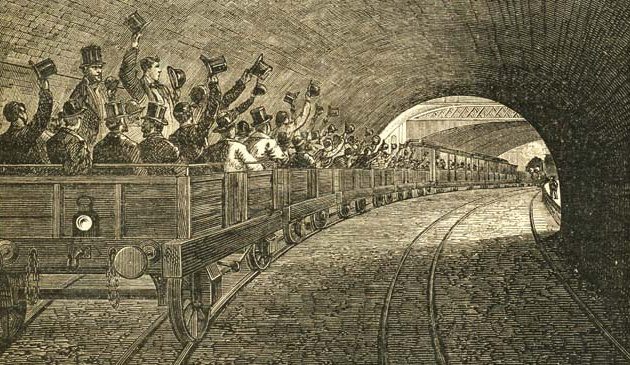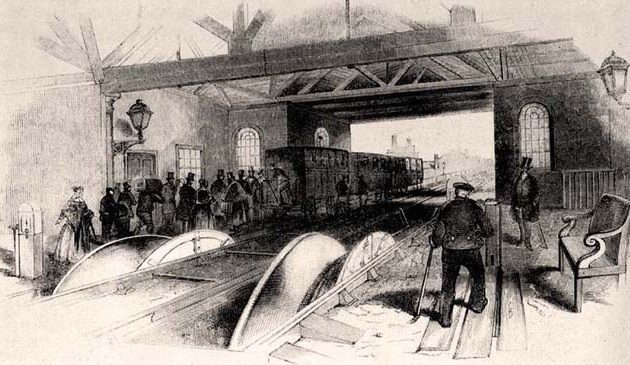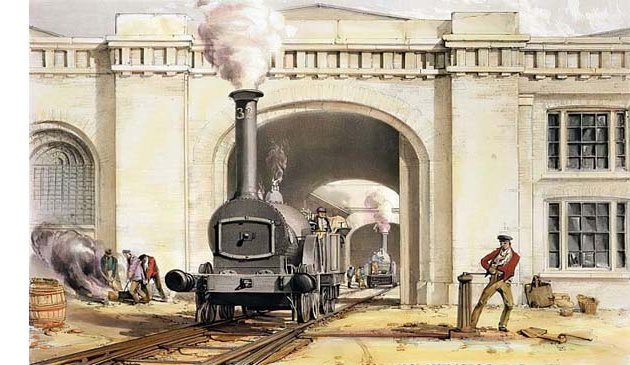The Metropolitan District railway – the creation of the Circle Line

Sloane Square station at the end of the 19th century. It was one of the original stations of the District Railway, opening on Christmas Eve 1868, and became a stop on the ‘inner circle’ upon its completion in 1884. Its construction was complicated by the underground River Westbourne crossing the line at that point. The river was carried over the station in a large pipe that can still be seen over the tracks today.
The impetus to complete the inner circle finally came when Parliament authorised a scheme by some businessmen to create the missing link with a line from Mansion House to Bow, supported by the District Railway. The proposed line would also link with the North London, Great Eastern, and East London railways. The backers were unable to raise the necessary finance, however, and the scheme did not proceed but it spurred the Metropolitan and District to cooperate, at least to the extent of competing the circle. Together they persuaded the Metropolitan Board of Works and the Commissioners of Sewers to contribute to the cost. A Bill was passed in 1879 to extend the Metropolitan as far as Tower Hill, with a spur to Whitechapel where it connected to the East London Railway.
The Metropolitan extension was opened in September 1882 with a station named Tower of London, where a rickety wooden booking office was erected that was to last for almost 60 years. It then took a further two years, and at great cost, for the Metropolitan to complete the final link in the circle, from Tower Hill to Mansion House. Trains began running around the full circle line in October 1884 with one ceremoniously driven around the full circuit followed by a banquet. Agreement between the two companies was that the Metropolitan ran trains clockwise and the District anticlockwise.
Despite the possibility to travel by train around the circle, it was necessary to buy different tickets for each company’s track. The Metropolitan and District each had separate ticket offices at shared stations. Ticket-sellers would often advise a hapless customer to make a lengthy journey around the circuit in one direction, when they could arrive at their destination in just a few stops by going the opposite way.
Each company initially attempted to run eight trains per hour, a schedule of 140 per day between them, but there were a further daily 684 trains from the mainline railway companies also running over the same tracks. The Metropolitan District railway simply could not cope with the vast amount of traffic, and trains were frequently held up waiting for others to pass, so services were much slower than previously operated on the individual lines.
Passenger numbers using the underground railway greatly increased with the completion of the inner circle. Yet the high costs involved in creating the enlarged network meant that profits were not adequate to pay District shareholders the dividends they had been promised on their investments. Strong competition from omnibuses, which had lower operational costs, forced both the Metropolitan and District to keep their ticket prices competitive. Distances between stations in the City, at the eastern end of the circle, were close enough that it was often as quick to walk or take an omnibus. That was particularly so because of the unreliable service and that the steam trains stopped for several minutes at Aldgate for watering. In the mid-1880s the District had to admit to shareholders that the circle was not profitable for them.
On several occasions London’s underground railway has been used by militants of one type or another to make a violent statement. Irish Republicans, generally known as Fenians, carried out many bombings during the 1880s. One such incident was on 30th October 1883 when two bombs were set off. One exploded in the tunnel between Embankment and Westminster Bridge stations. It was probably dropped from the previous train and its detonation delayed. Some damage occurred but no injuries. The second bomb was far more serious. It was dropped from a moving train between Praed Street and Edgware Road. Seventy-two passengers travelling in third-class carriages were injured, although none fatally. Another bomb exploded at Gower Street station in January 1885.
The City & South London underground railway, known as the ‘tube’, opened in 1890. That was followed by the Waterloo & City line, and in 1900 by the Central line. Each of these three new railways ran electric trains. The Metropolitan and District railways began experimenting with electric traction from May 1900 between Earls Court and Kensington High Street.
The District required investment for its electrification, which came from the American railway financier Charles Yerkes who thereafter took control of the company. He planned a different method of electrification to the Metropolitan and the matter had to be settled by arbitration. Yerkes formed the Underground Electric Railways Company in 1902, combining the District with several other London underground lines. The London Passenger Transport Board (London Transport) public body came into existence in July 1933, absorbing the UERC lines.
The Metropolitan Railway remained independent until also being incorporated into London Transport at the same time as the District. From 1949 the former Metropolitan and District inner circuit line appeared on London Underground maps as the ‘Circle Line’.
Sources include: G.A. Sekon ‘Locomotion in Victorian London’; Christian Wolmar ‘The Subterranean Railway’; Jerry White ‘London in the 19th Century’.


